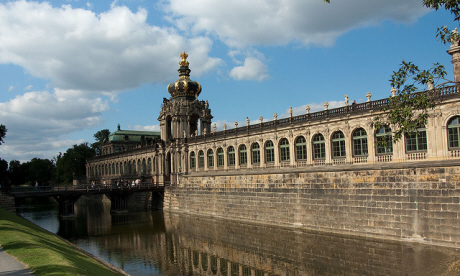
In the heart of Germany, a mix of the old and new makes for an ideal short trip and a wealth of opportunities for exploration
In Dresden, things are the way they used to be. The sound of Wagner and the smell of freshly baked stollen waft through the air around ornate, cherub-laden opera houses and Baroque roofs of the Altstadt (Old Town), now wonderfully recreated after obliteration in 1945.
Across the River Elbe lies the 19th-century Neustadt (New Town) and, beyond, the Aussere Neustadt (Outer New Town) – the lively bohemian quarter where students discuss Romanticism in dimly lit bars, where quirky shops sell everything from LPs to lace, and where a flurry of restaurants serves up every international cuisine under the sun. And if the Saxon beer sits heavily, you can walk it off among the sandstone hills of Saxon Switzerland, less than an hour from the city by rail.
From the airport, it’s just a 13-minute train ride on the S2 line to the Dresden Neustadt station. For a simple place to crash, head to Die Boofe, a hostel just ten minutes’ walk away with neat rooms and a pleasant bar and restaurant.
Also in Neustadt, the Rothenburger Hof is a recently renovated hotel that has apartments, a sauna and a swimming pool. There’s no shortage of hotels on both sides of the river, all cheaper than their counterparts in western Germany.
Once you’ve dumped your bags, it’s time to explore. This afternoon, make your way into the Aussere Neustadt, home to wacky art and antique shops – don’t miss the Kunsthof, a series of connected courtyards, each imaginatively themed (the Court of the Elements, for example), where you’ll find second-hand clothes, books and wines.
If you’re feeling peckish, make your way to multi-cultural Louisenstrasse where Arab, Greek, Indian, Mexican and Turkish restaurants jostle for space. There’s also a great stand-up soup bar called Soul Food Sisters.
Although stollen is a fragrant fruit loaf that’s traditionally made for Advent, it’s available year-round in bakeries all over the city. Another picnic must is some cheese from Pfunds Dairy (founded in 1880) on nearby Bautzner Strasse, one of the most beautiful cheese shops you’ll ever see. Pick out some whiffy local specialities among the ornate neo-Renaissance tiles of the shop or head upstairs for a fondue in the restaurant.
In the morning, catch the S1 train (leaving Neustadt station at 51 minutes past the hour) east to the station of Schmilka, just short of the Czech border – in addition to hikers, many of your fellow passengers will be Dresdeners walking across the border for cheap beer and shopping. From the train station, jump onto the tiny ferry across to Schmilka itself, from where you can walk up the hamlet’s one street and into the green hills of Saxon Switzerland.
This is unique countryside – sandstones laid down 100 million years ago have been compacted, deformed and eroded, leaving flat-topped mesas, with deep, fir-filled gullies running between them. On top, the plateaus are capped with scrambling heather and bilberry bushes while peregrines, kestrels and swifts wheel through the air.
It’s little more than an hour’s hike to the Grosswinterberg, a peak of 556m from where you can sit and gaze at the spectacular views across the mesas and across into the Czech Republic. There’s a hotel and restaurant at the top, but why not find your own private spot and settle down for some bread and a bit of that Pfunds’ Dairy cheese?
Hiking onwards, you’ll drop down to the hamlet of Zeughaus, tucked away in a small valley, where there’s a hikers’ bunkhouse you can use this as your base. Otherwise, continue down the valley for an hour or so and you’ll reach the Kirnitzsch valley, which you can follow downstream to the Lichtenhainer waterfall.
Here you can jump on a vintage tram, the Kirnitzschtalbahn, which will chug through to the spa town of Bad Schandau; alternatively you can hike there in two-and-a-half hours. Stay the night here in Bad Schandau – there are plenty of sweet guesthouses, or try the smart but reasonable Hotel Sigl’s.
The next day, leave the quiet charm of Bad Schandau and jump on a train back to Dresden – it’s time to see something of the famous old town. From the Mitte station it’s a short walk east to the wonderful Baroque courtyard of the Zwinger, ringed by great museums and art galleries, and beyond it the royal palace and cathedral.
One of the city’s oddest museums is the German Hygiene Museum, on Lingnerplatz; it’s stuffed with exhibits on bodily functions of every kind, including the iconic Transparent Man (currently a woman).
Don’t miss Friedrichstadt, once a prosperous suburb and now semi-dormant. You’ll pass the 200m-long Baroque façade of the Marcolini Palace, where Napoleon and Wagner both lived; it’s now a hospital, but you can wander through the gardens to the massive Fountain of Neptune. Beyond is the port, where you should seek out the Fischhaus Alberthafen, a fish restaurant that’s a long-standing local favourite.
Heading back into the heart of the city along Magdeburger Strasse, you can’t miss the bizarre sight of a factory disguised as a mosque. This is the unique Yenidze building, built in 1908 as a cigar factory but modelled on an ancient tomb in Cairo. The cupola terrace makes a superb location for an afternoon beer or two, looking east up the Elbe, before contemplating the flight home.